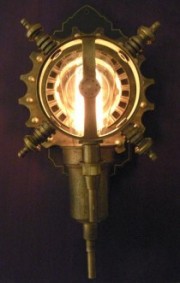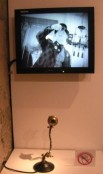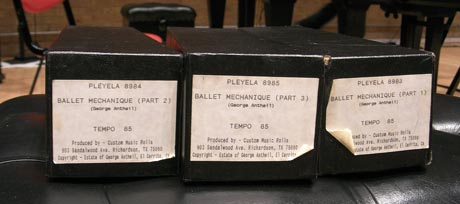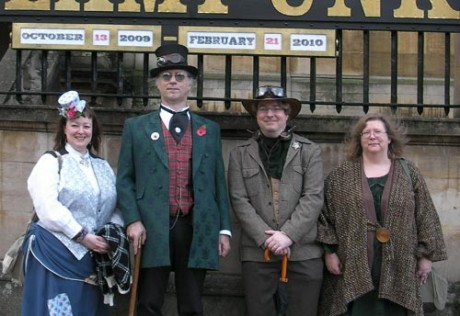Posts from — November 2009
In Memoriam: Florence Boyd-Graham
The Passing of a Grand Woman
Florence Boyd-Graham: Dec 22, 1913 — Nov 24, 2009
Florence was born in Toronto into the era of the First World War, lived through The Great Depression, and with her husband, Lt Cdr William A. Graham (RCN, RN, RCNR) and four (soon five) children, survived the Second World War in Halifax, Nova Scotia.
The family moved back to Toronto, did another NS stint followed by over 50 years based in Oakridge Acres, London. Losing her mother Nell at age 15 impacted her greatly: she dedicated herself to mothering, followed by first class grand and great-grand-mothering.
Having seen her children through the various levels of higher education, she returned to University (the University of Western Ontario) herself in her late 70s, graduating with a BA/Hons BA (but did an equivalent of an MA) in Philosophy. During these years, she worked in Veterans Affairs, was a member of the United Church, the Unitarian Fellowship (a dedicated choir member in both), and the Albert Schweitzer Society, followed by the Raging Grannies (add ‘Reveling,’ she always said) who sing protest songs for good causes.
On the environmental front, in 1962 she brought home Rachel Carson’s Silent Spring, got involved in ‘Pollution Probe’ and The Coop Store. An active member of CFUW and the Oakridge Ratepayers Association, she never ceased doing public service.
She travelled widely to visit her children far and wide, and became a fond supporter of The Findhorn Community in NE Scotland (where she visited eight times).
Her favourite gatherings were her local weekly ‘coffee group’ with dear friends Pat Dinsmore and the late Evelyn March, her monthly book club with David Smith and friends—and of course good-spirited bridge parties!
Florence was, in essence, a grassroots philosopher who spoke her mind, whose search for ‘truth’ was unstinting. Her interests were both wide-ranging and breathtaking. Our family home, ‘540’, was virtually an Open House for over 50 years, featuring notable parties, workshops and late night sessions. She brought the World into the Canadian suburbs and turned her backyard into a woodland wildlife haven. She represented the best Canada can boast of: A Grand Woman—not a ‘lady’, she said, that smacked too much of ‘the aristocratic’.
Our world is less without her physical presence, but indeed, she walks tall amongst us in the best of Canadian life, what made us Canada from 1913–2009, and through her surviving children, Robert, Joan, Leona and Ralph—her darling youngest son Ian passed away in 2005—and finally through her grand-children Laura, John, Bruce, Nathalie, Kim-Ellen, Lila, Alex, Lara and Danny; and her great-grandchildren Gabriella, Garrett, Sean, Geordy and Charlton.
Fly high and free ‘Sophia’-Florence, as you travel the heights with Socrates and Plato—and of course, the Great Sappho.
A memorial service was held at Mt Pleasant Chapel on Friday December 4 from 1–2pm (see programme below).
Main photo courtesy of the London Free Press
November 29, 2009 Comments Off on In Memoriam: Florence Boyd-Graham
Ballet mécanique in Cambridge
On Sunday last I had the almost unique opportunity to attend a performance of George Antheil’s Ballet mécanique at the West Road Concert Hall in Cambridge, part of the Cambridge Music Festival. The concert also marked the 100th anniversary year of the publication of the Futurist Manifesto.
My attention was drawn to the event by my friend Paul Lehrman, whom I knew originally as a brilliant journalist who used to write for me when I was Editor of Studio Sound back in the 1980s. Since then we’ve done a bunch of stuff together including music for KPM Music Library and much more.
Today, Paul is a music professor based at a university in the Boston area, and he has made quite a name for himself for his realisation of a version of Antheil’s work which calls (at least in its full version) for a percussion orchestra of three xylophones, four bass drums and a tam-tam (gong); two live pianists; seven or so electric bells; a siren; three aeroplane propellers; and 16 synchronized player pianos. As you can imagine, it’s a flamboyant, controversial, downright noisy piece of avant-garde music.
This large-scale version of the piece, composed around 1923, was never performed in Antheil’s lifetime, apparently because the friend of Antheil’s who told him you could sync up 16 player pianos was wrong: the technology of the time did not allow it. Paul Lehrman, however, was commissioned by music publishers G. Schirmer to realise the work for the 16 player pianos called for in the original manuscript, using modern digital technology in the form of digital player pianos, MIDI, and samples for the aircraft propellers.
This he did, and the first performance took place at the University of Massachusetts, Lowell, exactly ten years ago (on 18 November, 1999). Since then it’s been performed on numerous occasions around the world. You can read more about it, and about Antheil, at Paul’s site which you can find here at antheil.org.
This was not the version performed at West Road on Sunday, however. That was a somewhat more restrained version performed on this occasion on a single Pianola plus two live pianists, three xylophones, drums and percussion, rattles (performing the propeller parts), two electric doorbells and a hard-cranked siren. Musically, it was a version first performed in 1927 (and not very often thereafter). Paul asked me if I could go along and interview Paul Jackson, the conductor, experience the performance and find the answers to some questions about this particular version.
This sounded as if it could be enormous fun (which indeed it was) so I duly turned up for the event, Music hard and beautiful as a diamond, part of the 2009 Cambridge Music Festival, consisting of three works performed by Rex Lawson on Pianola, Julio d’Escriván on iPhone, the Anglia Sinfonia, Anglia Voices and MEME, conducted by Paul Jackson.
The concert itself was preceded by a 45-minute presentation by Lawson and d’Escriván about the Pianola and the iPhone as an instrument respectively (d’Escriván’s piece started the evening). I was particularly interested in Lawson’s exposition on the Pianola.
The Pianola is quite different from the Reproducing Piano and is not even truly the stuff of “player pianos” in saloons in cowboy movies, though they all use a “piano roll” to provide the notes. In the case of the Reproducing Piano, the roll contains not only the notes but all the tempo, expression and other aspects of an actual performance. Thus the big selling point of these systems, therefore, was to get famous performers and composers to perform their works, which could then be flawlessly reproduced at home.
The Pianola, on the other hand, began life as a “cabinet player” – a box on castors that you wheel up to a conventional piano (a Steinway grand in the case of the Sunday performance) and lock into place so that its felt-covered actuators can press the keys. It’s powered by pedals, which drive the roll and also force air through the holes in the roll to sound the notes. By changing the pressure on the pedals (eg by stamping on them) you can also change the loudness of the notes – in other words, give the performance dynamics – that can be applied to different parts of the range. There’s also a tempo slider – and even technology that picks out the top line automatically.
This is all rather important, because the piano roll for a Pianola contains only the notes – the player determines the tempo and expression (in a solo performance, for example, including visual cues printed or written on the roll). Thus a Pianola performance actually is a performance, and not a playback. Yes, the notes are provided, but the expression is manually applied.
Pianola rolls were not created by playing the instrument and recording what the performer did, as in the case of the Reproducing Piano. Instead, they were created simply from the score. Imagine a MIDI sequence created in step-time with no velocity information and you get the idea.
Most people couldn’t be bothered to learn the subtle nuances of Pianola performance, however, and simply pedalled away, giving the instruments a rather lifeless, mechanical reputation which was entirely undeserved. Ultimately, mechanisms were built into (usually upright) pianos – and hence the player pianos in the bars depicted in the cowboy movies aforementioned.
Rex Lawson, who performed the Pianola part in Sunday’s concert, is a leading expert on the instrument, and his presentation disposed of quite a few myths, especially when it came to the performance of Ballet mécanique. The fact that the player controls the tempo means that the Pianola can actually follow a conductor in the conventional way – the Pianola does not have to set the tempo and have every other player sync to it. In Paul Lehrman’s performances, in contrast, the MIDI replay system that drives the player pianos also generates a click track that everyone follows.
Similarly, the fact that you can control the dynamics of the Pianola means that the instrument does not simply bash out all the notes at full blast. As a result, primarily, of these two factors, Ballet mécanique takes on a whole new degree of light and shade. Yes, it’s still a cacophony of 20s avant-garde exuberance, but it takes on a good deal of additional subtlety.
Lawson feels that the piece is designed to be played on these Edwardian instruments rather than modern digital systems, and that you need to actually perform the Pianola part – as he puts it, you need to “sweat”. However, he is interested in getting some fellow Pianola-owning friends together to perform the work on four Pianolas synchronised as far as tempo is concerned.
Lawson thinks the idea of 16 player pianos was Antheil showing off, that it was probably originally intended for four live pianists, and that the big problem with performing it at the time was that there were not nearly enough players in Paris who knew the subtleties of the Pianola and how to use its tempo and expression capabilities. In his planned 4‑Pianola performance, he would set the tempo at his Pianola and the others would follow the tempo he set by using stepper motors to sync them to his unit. Which sounds like a great idea, though there might be issues due to stretching or slippage of the rolls: it might need sprocketed piano rolls, which did actually exist.
The Sunday performance of the single-Pianola version used three piano rolls, and to allow changing them the performance was split into three movements.
The performance, for me, shed new light on a fascinating composition from the 1920s. A radically different interpretation from Paul Lehrman’s, it suggests interesting possibilities for a Lawson/Lehrman collaboration.
• The programme also included Grand Pianola Music by John Adams (no Pianolas involved), and Julio d’Escriván’s ingenious and expressive Ayayay! Concerto for iPhone, Pianola and orchestra.
November 25, 2009 Comments Off on Ballet mécanique in Cambridge
& Simpson">“Only Remembered” — Coope Boyes & Simpson
In this video, leading British folk musicians Coope Boyes & Simpson provide the music in their unique and moving acapella style with the song “Only Remembered”, as we view aspects of the unique exhibition by the University of Oxford’s First World War Poetry Digital Archive in the immersive 3D virtual world of Second Life.
The exhibition simulates aspects of life in the trenches on the Western Front during the 1914–1918 war and presents work by the “War Poets” of the period.
As visitors explore the simulation, they can listen to the voices of veterans recounting their experiences of the war, view original film footage and photographs from the time, and learn about life on the Western Front, encountering some of the most powerful poetry in English literature by seeing the original manuscripts, turning the pages of the poets’ war diaries and letters, and listening to readings.
The video is taken from the 10 November 2009 episode of the TV series Designing Worlds, a weekly live show covering design and designers in virtual worlds, produced by Prim Perfect magazine and Treet.TV.
“Only Remembered” (Bonar/Sankey/Tams Voice Publishing) is used by permission and is taken from the album Private Peaceful The Concert (No Masters NMCD24) by Coope Boyes & Simpson.
For more information, read this article on The First World War Poetry Digital Archive in Second Life.
November 14, 2009 Comments Off on “Only Remembered” — Coope Boyes & Simpson
Working at the World Wilderness Congress
Leona helped to co-ordinate resources at the 9th World Wilderness Congress (WWC), in Merida, Mexico between the 6th and 13th of November.
“Launched by The WILD Foundation in 1977, the World Wilderness Congress (WWC) is now the longest-running, public, international environmental forum. With over 30 years of conservation achievements, the WWC has become a high-profile platform for acting on complex wilderness and wildlands issues.
“WWCs include senior-level representation from governments, the private sector, native peoples, non-governmental organizations, academia and the arts in a structure carefully designed to bring together the full spectrum of wilderness-related views. Broad-based participation, combined with the spirit of open and balanced debate, creates a constructive, objective oriented environment, and generates practical conservation outcomes.
“The Congress convenes every three to four years around the world. Past WWCs have been held in South Africa (1977, 2001), Australia (1980), Scotland (1983), USA (1987, 2005), Norway (1993), and India (1998).
“Since its origins, the World Wilderness Congress has been a result-oriented conservation project that begins long before the actual convention of delegates takes place, and WILD 9 will be no different. In the months leading up to Merida, several committees, groups, agencies and organizations are working on models, objectives and targets that address a global agenda and aim to achieve practical conservation results through a diverse and interesting program –with a Latin rhythm!”
Click here for more information.
Last day’s feed from the Congress:
Video clips at Ustream
November 4, 2009 Comments Off on Working at the World Wilderness Congress
Oxford University’s virtual First World War site opens in Second Life
I’d like to draw your attention to the following press release regarding the opening of the Second Life presence of Oxford University’s First World War Poetry Digital Archive. I was involved in recording some of the audio for this project, including several poetry readings, tutorials and the introduction and epilogue to the installation. More details here; video at foot of this article.
An exciting new project in interactive education will launch on 2nd November 2009, drawing together the resources and expertise of the University of Oxford, and the possibilities for immersion and interactivity offered by the virtual world of Second Life.
The First World War Poetry Digital Archive and the Learning Technologies Group at the University of Oxford have collaborated to bring together a wealth of digitised archival material from the First World War into an environment that allows this powerful material to be explored and experienced in a radically new way.
“The aim of the initiative is to place the poetry of the Great War in context,” explains Stuart Lee, Lecturer in English at the University of Oxford, “It allows the visitors to the exhibition to visualise archival materials in an environment that fosters deeper understandings. Visitors also have the opportunity to take advantage of the social and interactive aspects that the environment offers.”
The project has imported into the Second Life environment a range of digitised archival materials from the major poets of the First World War (including poetry manuscripts, letters and diaries) along with contextual primary source materials. These have been positioned within an environment which has been modelled to represent areas of the Western Front, 1914 — 1918.
The materials have been supplemented with new interpretative content and a spectrum of interactive tools and tutorials, streaming video and audio effects to create a vivid immersive experience that is, according to visitors, deeply moving.
“I had, of course, read about the First World War, and seen archive news footage too,” says Saffia Widdershins, a Second Life resident. “But to have the feeling of walking along narrow trenches on duckboards half covered in mud, to see the dugouts, or to stand in a dressing station, hearing the voices of people who had been there describing their own experiences – this is all incredibly powerful.”
There will be a Second Life Press Launch at 4.30am SLT (12.30 UK time) and again at 2pm SLT (22:00 UK time) on Monday 2nd November. Come to the landing point at: http://slurl.com/secondlife/Frideswide/219/199/646/ and take the TP to Theatre.
The installation will be open for exploration from 2am Monday 2nd November 2009. We ask visitors to preserve the atmosphere of this environment by wearing the clothing provided at the landing area.
November 1, 2009 Comments Off on Oxford University’s virtual First World War site opens in Second Life
Steampunk in Oxford
 This weekend I had the pleasure of spending a day with a colloquy of friends in the venerable University city of Oxford, centred around a visit to the Museum of the History of Science to see their Steampunk Art exhibition.
This weekend I had the pleasure of spending a day with a colloquy of friends in the venerable University city of Oxford, centred around a visit to the Museum of the History of Science to see their Steampunk Art exhibition.
I’d been past this building before – it’s the original home of the Ashmolean – but never inside. Turns out it’s a wonderful little museum on about three floors and a veritable storehouse of ancient scientific instruments of all shapes and size, with an emphasis on brass and the odd bit of mahogany.
The museum would be worth visiting at any time just to take in the development of scientific and technological instruments over the last few hundred years – there are microscopes, telescopes, astrolabes, electrical machines and a great deal more – but it also made the perfect location for the first UK museum exhibit of Steampunk Art, which runs until February 21, 2010. I would recommend a visit if you’re in the area or can arrange to be.
 Steampunk, one could say, is a genre that imagines what might have happened if the technology of the 19th century had not been eclipsed by that of the 20th. It’s Jules Verne and H G Wells’ vision of technology; you also get a certain feeling of it from Oxfordian Philip Pullman’s His Dark Materials trilogy.
Steampunk, one could say, is a genre that imagines what might have happened if the technology of the 19th century had not been eclipsed by that of the 20th. It’s Jules Verne and H G Wells’ vision of technology; you also get a certain feeling of it from Oxfordian Philip Pullman’s His Dark Materials trilogy.
Thus the basement of the Museum is currently filled with all manner of mysterious contraptions with glowing incandescent filaments, whirling (or potentially whirling) mechanisms, and mechanical prosthetics. Some of them are shown in the accompanying photographs.
I was joined by Oxford resident Polly (with whom I work on Designing Worlds), Lynne (my collaborator on the iPhys projects for Sunderland City College) and her husband Richard, and also, at least for part of the day, by Ann and Knick who it was lovely to see again and kindly put me up for the weekend.
 After the exhibition and some refreshment, we took in the last full day of a fascinating exhibition on book-binding at the Bodleian, followed by the open-top bus tour of the city, which is worth the effort. Mid-afternoon we ended up at Blackwells’ where we all seemed to acquire a set of John Grant’s series of science books, Discarded, Corrupted and Bogus Science. We then retired to the coffee shop upstairs to discuss falling standards in British secondary and further education.
After the exhibition and some refreshment, we took in the last full day of a fascinating exhibition on book-binding at the Bodleian, followed by the open-top bus tour of the city, which is worth the effort. Mid-afternoon we ended up at Blackwells’ where we all seemed to acquire a set of John Grant’s series of science books, Discarded, Corrupted and Bogus Science. We then retired to the coffee shop upstairs to discuss falling standards in British secondary and further education.
 In the evening, an excellent dinner at the Trout in Wolvercote.
In the evening, an excellent dinner at the Trout in Wolvercote.
November 1, 2009 Comments Off on Steampunk in Oxford









